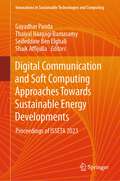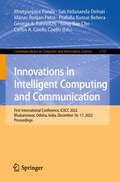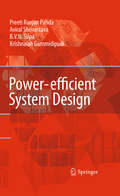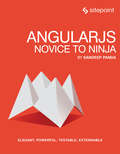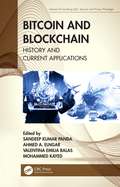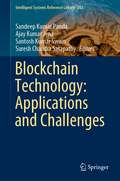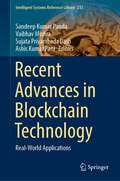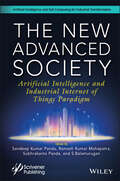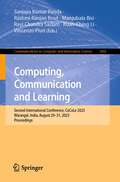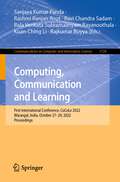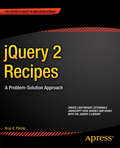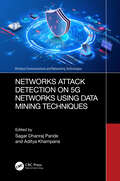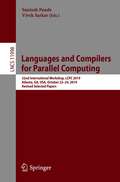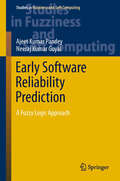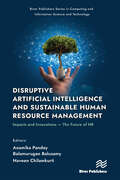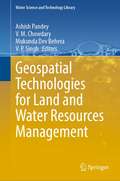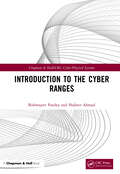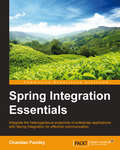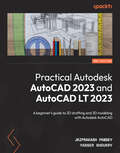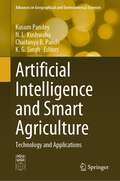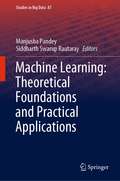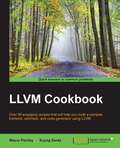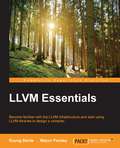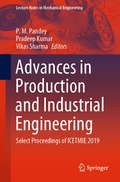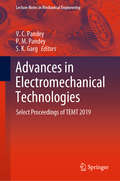- Table View
- List View
Digital Communication and Soft Computing Approaches Towards Sustainable Energy Developments: Proceedings of ISSETA 2023 (Innovations in Sustainable Technologies and Computing)
by Gayadhar Panda Thaiyal Naayagi Ramasamy Seifeddine Ben Elghali Shaik AffijullaThis book is a second volume and contains selected papers presented at Second International Symposium on Sustainable Energy and Technological Advancements (ISSETA 2023), organized by the Department of Electrical Engineering, NIT Meghalaya, Shillong, India, during 24 – 25 February 2023. The topics covered in the book are the cutting-edge research involved in sustainable energy technologies, smart buildingtechnology, integration and application of multiple energy sources; advanced power converter topologies and their modulation techniques; and information and communication technologies for smart microgrids.
Innovations in Intelligent Computing and Communication: First International Conference, ICIICC 2022, Bhubaneswar, Odisha, India, December 16-17, 2022, Proceedings (Communications in Computer and Information Science #1737)
by Mrutyunjaya Panda Satchidananda Dehuri Manas Ranjan Patra Prafulla Kumar Behera George A. Tsihrintzis Sung-Bae Cho Carlos A. Coello CoelloThis book contains the papers presented at the First International Conference on Innovations in Intelligent Computing and Communication, ICIICC 2021, held in Bhubaneswar, Odisha, India, in December, 2022. The 31 full papers presented were thoroughly reviewed and selected from 78 submissions. They are divided in three tracks with the following topics: Intelligent Computing; Communications; and Machine Learning and Data Analytics.
Power-efficient System Design
by Preeti Ranjan Panda Krishnaiah Gummidipudi B. V. Silpa Aviral ShrivastavaThis book addresses power optimization in modern electronic and computer systems. Several forces aligned in the past decade to drive contemporary computing in the direction of low power and energy-awareness: the mobile revolution took the world by storm; power budgets forced mainstream processor designers to abandon the quest for higher clock frequency; and large data centers with overwhelming power costs began to play vital roles in our daily lives. Power optimization was elevated to a first class design concern, forcing everyone from the process engineer, circuit designer, processor architect, software developer, system builder, and even data center maintainer to make conscious efforts to reduce power consumption using myriad techniques and tools. This book explores power optimization opportunities and their exploitation at various levels of abstraction. Fundamental power optimizations are covered at each level of abstraction, concluding in a case study illustrating the application of the major techniques to a graphics processor. This book covers a comprehensive range of disparate power optimizations and is designed to be accessible to students, researchers, and practitioners alike.
AngularJS: Elegant, Powerful, Testable, Extendable
by Sandeep PandaAngularJS: Novice to Ninja is your fast track route to mastering AngularJS, the superheroic JavaScript framework. AngularJS provides the fastest, most efficient way to build single page web applications.What will I learn?In this practical and fun-to-read book, you'll learn the fundamentals of AngularJS, such as scopes, modules and controllers. You'll then move on to more sophisticated techniques, including using directives, filters and expressions to build a full single page web application.Discover the power of AngularJS's two-way data bindingUsing AngularJS and TDDGet to grips with modules, scopes, and controllersEnhance your HTML with directivesBuild a complete working single page blog application as you learn And much more
Bitcoin and Blockchain: History and Current Applications (Internet of Everything (IoE))
by Sandeep Kumar Panda Ahmed A. Elngar Valentina Emilia Balas Mohammed KayedIn recent years, blockchain development has grown quickly from the original Bitcoin protocol to the second-generation Ethereum platform, and to today’s process of building third-generation blockchains. During this evolution, we can see how blockchain technology has evolved from its original form as a distributed database to becoming a fully fledged, globally distributed, cloud computing platform. This book traces the past, present, and future of blockchain technology. Presents the knowledge and history of Bitcoin Offers blockchain applications Discusses developing working code for real-world blockchain applications Includes many real-life examples Covers the original Bitcoin protocol to the second-generation Ethereum platform Bitcoin and Blockchain: History and Current Applications is a useful reference for students, business schools, research scholars, practitioners, and business analytics professionals.
Blockchain Technology: Applications and Challenges (Intelligent Systems Reference Library #203)
by Sandeep Kumar Panda Ajay Kumar Jena Santosh Kumar Swain Suresh Chandra SatapathyThis book discusses the various open issues of blockchain technology, such as the efficiency of blockchain in different domains of digital cryptocurrency, smart contracts, smart education system, smart cities, cloud identity and access, safeguard to cybersecurity and health care. For the first time in human history, people across the world can trust each other and transact over a large peer-to-peer networks without any central authority. This proves that, trust can be built not only by centralized institution but also by protocols and cryptographic mechanisms. The potential and collaboration between organizations and individuals within peer networks make it possible to potentially move to a global collaborative network without centralization. Blockchain is a complex social, economic and technological phenomenon. This questions what the established terminologies of the modern world like currency, trust, economics and exchange would mean. To make any sense, one needs to realize how much insightful and potential it is in the context and the way it is technically developed. Due to rapid changes in accessing the documents through online transactions and transferring the currency online, many previously used methods are proving insufficient and not secure to solve the problem which arises in the safe and hassle-free transaction. Nowadays, the world changes rapidly, and a transition flow is also seen in Business Process Management (BPM). The traditional Business Process Management holds good establishment last one to two decades, but, the internal workflow confined in a single organization. They do not manage the workflow process and information across organizations. If they do so, again fall in the same trap as the control transfers to the third party that is centralized server and it leads to tampering the data, and single point of failure. To address these issues, this book highlights a number of unique problems and effective solutions that reflects the state-of-the art in blockchain Technology. This book explores new experiments and yields promising solutions to the current challenges of blockchain technology. This book is intended for the researchers, academicians, faculties, scientists, blockchain specialists, business management and software industry professionals who will find it beneficial for their research work and set new ideas in the field of blockchain. This book caters research work in many fields of blockchain engineering, and it provides an in-depth knowledge of the fields covered.
Recent Advances in Blockchain Technology: Real-World Applications (Intelligent Systems Reference Library #237)
by Sandeep Kumar Panda Vaibhav Mishra Sujata Priyambada Dash Ashis Kumar PaniThis book provides insights on blockchain technology and its applications in real-world business, supply chain, health care, education, HRM, retail, logistics and transport industries. This book grants a comprehensive understanding of how this technology is functioning within modern real-world applications and how it can influence the future of the real-world applications in industry. The chapters cover the case study, applications of blockchain, benefits and challenges, disruptive innovations in real-world applications, privacy and security concerns, and the recent trends of blockchain in real-world applications. It is ideally intended for marketers, advertisers, brand managers, executives, managers, IT specialists and consultants, researchers, businesses, practitioners, stakeholders, academicians, and students interested in blockchain technology and its role in supply chain, health care, education, HRM, retail, logistics and transport industries.
The New Advanced Society: Artificial Intelligence and Industrial Internet of Things Paradigm (Wiley-Scrivener)
by Sandeep Kumar Panda Ramesh Kumar Mohapatra Subhrakanta Panda S. BalamuruganTHE NEW ADVANCED SOCIETY Included in this book are the fundamentals of Society 5.0, artificial intelligence, and the industrial Internet of Things, featuring their working principles and application in different sectors. A 360-degree view of the different dimensions of the digital revolution is presented in this book, including the various industries transforming industrial manufacturing, the security and challenges ahead, and the far-reaching implications for society and the economy. The main objective of this edited book is to cover the impact that the new advanced society has on several platforms such as smart manufacturing systems, where artificial intelligence can be integrated with existing systems to make them smart, new business models and strategies, where anything and everything is possible through the internet and cloud, smart food chain systems, where food products can be delivered to any corner of the world at any time and in any situation, smart transport systems in which robots and self-driven cars are taking the lead, advances in security systems to assure people of their privacy and safety, and smart healthcare systems, where biochips can be incorporated into the human body to predict deadly diseases at early stages. Finally, it can be understood that the social reformation of Society 5.0 will lead to a society where every person leads an active and healthy life. Audience The targeted audience for this book includes research scholars and industry engineers in artificial intelligence and information technology, engineering students, cybersecurity experts, government research agencies and policymakers, business leaders, and entrepreneurs. Sandeep Kumar Panda, PhD is an associate professor in the Department of Data Science and Artificial Intelligence at IcfaiTech (Faculty of Science and Technology), ICFAI Foundation for Higher Education, Hyderabad. His research areas include artificial intelligence, IoT, blockchain technology, cloud computing, cryptography, computational intelligence, and software engineering. Ramesh Kumar Mohapatra, PhD is an assistant professor in the Department of Computer Science and Engineering, National Institute of Technology, Rourkela, Odisha, India. His research interests include optical character recognition, document image analysis, video processing, secure computing, and machine learning. Subhrakanta Panda, PhD is an assistant professor in the Department of Computer Science and Information Systems, BITS-PILANI, Hyderabad Campus, Jawahar Nagar, Hyderabad, India. His research interests include social network analysis, cloud computing, security testing, and blockchain. S. Balamurugan, PhD is the Director of Research and Development, Intelligent Research Consultancy Services (iRCS), Coimbatore, Tamilnadu, India. He is also Director of the Albert Einstein Engineering and Research Labs (AEER Labs), as well as Vice-Chairman, Renewable Energy Society of India (RESI), India. He has published 45 books, 200+ international journals/ conferences, and 35 patents.
Computing, Communication and Learning: Second International Conference, CoCoLe 2023, Warangal, India, August 29–31, 2023, Proceedings (Communications in Computer and Information Science #1892)
by Sanjaya Kumar Panda Rashmi Ranjan Rout Manjubala Bisi Ravi Chandra Sadam Kuan-Ching Li Vincenzo PiuriThis volume constitutes the refereed proceedings of the Second International Conference on Computing, Communication and Learning, CoCoLe 2023, held in Warangal, India, in August 29–31, 2023.The 25 full papers presented were carefully reviewed and selected from 120 submissions. The CoCoLe conference focuses on Application of Supervised Learning in Computing; Application of Unsupervised Learning in Computing; and Computing in Communication Networks.
Computing, Communication and Learning: First International Conference, CoCoLe 2022, Warangal, India, October 27–29, 2022, Proceedings (Communications in Computer and Information Science #1729)
by Sanjaya Kumar Panda Rashmi Ranjan Rout Ravi Chandra Sadam Bala Venkata Subramaanyam Rayanoothala Kuan-Ching Li Rajkumar BuyyaThis volume constitutes the refereed proceedings of the First International Conference on Computing, Communication and Learning, CoCoLe 2022, held in Warangal, India, in October 2022.The 25 full papers and 1 short paper presented were carefully reviewed and selected from 117 submissions. The CoCoLe conference focuses on three broad areas of computer science and other allied branches, namely computing, communication, and learning.
jQuery 2 Recipes
by Arun K. PandejQuery is often referred to as the 'write less, do more' JavaScript library. It allows a few clear lines of elegant, well-tested, code to replace many pages of complex hand-coded script, speeding development times and providing substantial cost savings. You will find jQuery 2 Recipes' problem-solution approach to be an excellent value and a feature-packed resource as you begin to include jQuery in your own projects. This book is bursting with fully-worked example recipes showing the core jQuery frameworks (jQuery, jQuery Mobile, jQuery UI) in action. Starting with fundamental principals and progressing to more advanced topics you'll be shown how to make the very best use of jQuery every step of the way. Early on, you'll learn to work confidently with dynamic data and to handle the jQuery events that form the foundation of your application. We'll then build on this foundation to demonstrate how fully working user-interface animations and AJAX data-validation can be constructed within jQuery. We'll show how add-on libraries like jQwidgets can be deployed to create professional quality apps for both the desktop and web with minimal coding. Finally, a full set of debugging and error-handling recipes is included to help you track down bugs and ensure your code is as robust as it can be. What you'll learn This book contains a comprehensive collection of recipes that will help you solve a wide range of jQuery 2. 0 problems. Follow working examples of the main features of all three core jQuery frameworks (jQuery, jQuery UI and jQuery Mobile) in action. See how to integrate jqWidgets into your application effectively. Learn the techniques to create and implement custom animations and effects using jQuery methods. Follow tried-and-tested debugging recipes to streamline your applications. Who this book is for This book is written for developers with a basic working knowledge of jQuery, HTML and CSS, who want to broaden their learning. You should be comfortable creating basic programs and understand the role that jQuery plays within an application before you begin reading. Table of Contents Chapter 1 Introduction Chapter 2 jQuery Fundamentals Chapter 3 jQuery Selectors Chapter 4 jQuery Selectors Filtering and Expansion Chapter 5 DOM Traversing Chapter 6 DOM Manipulation Chapter 7 Event Handling Chapter 8 jQuery Effects and Animation Chapter 9 jQuery AJAX Chapter 10 jQuery UI Chapter 11 jQuery Mobile Chapter 12 jqWidgets Framework Appendix A Basic HTML5 and CSS3 Appendix B Web Console Appendix C Deploy Web Application Appendix D Logging, Error Handling, and Debugging
Networks Attack Detection on 5G Networks using Data Mining Techniques (Wireless Communications and Networking Technologies)
by Sagar Dhanraj Pande Aditya KhampariaArtificial intelligence (AI) and its applications have risen to prominence as one of the most active study areas in recent years. In recent years, a rising number of AI applications have been applied in a variety of areas. Agriculture, transportation, medicine, and health are all being transformed by AI technology. The Internet of Things (IoT) market is thriving, having a significant impact on a wide variety of industries and applications, including e-health care, smart cities, smart transportation, and industrial engineering. Recent breakthroughs in artificial intelligence and machine learning techniques have reshaped various aspects of artificial vision, considerably improving the state of the art for artificial vision systems across a broad range of high-level tasks. As a result, several innovations and studies are being conducted to improve the performance and productivity of IoT devices across multiple industries using machine learning and artificial intelligence. Security is a primary consideration when analyzing the next generation communication network due to the rapid advancement of technology. Additionally, data analytics, deep intelligence, deep learning, cloud computing, and intelligent solutions are being employed in medical, agricultural, industrial, and health care systems that are based on the Internet of Things. This book will look at cutting-edge Network Attacks and Security solutions that employ intelligent data processing and Machine Learning (ML) methods.This book: Covers emerging technologies of network attacks and management aspects. Presents artificial intelligence techniques for networks and resource optimization, and toward network automation, and security. Showcases recent industrial and technological aspects of next-generation networks Illustrates artificial intelligence techniques to mitigate cyber-attacks, authentication, and authorization challenges. Explains smart, and real-time monitoring services, multimedia, cloud computing, and information processing methodologies in 5G networks. It is primarily for senior undergraduates, graduate students and academic researchers in the fields of electrical engineering, electronics and communication engineering, computer engineering, and information technology.
Languages and Compilers for Parallel Computing: 32nd International Workshop, LCPC 2019, Atlanta, GA, USA, October 22–24, 2019, Revised Selected Papers (Lecture Notes in Computer Science #11998)
by Santosh Pande Vivek SarkarThis book constitutes the thoroughly refereed post-conference proceedings of the 32nd International Workshop on Languages and Compilers for Parallel Computing, LCPC 2019, held in Atlanta, GA, USA, in October 2019.The 8 revised full papers and 3 revised short papers were carefully reviewed and selected from 17 submissions. The scope of the workshop includes advances in programming systems for current domains and platforms, e.g., scientific computing, batch/ streaming/ real-time data analytics, machine learning, cognitive computing, heterogeneous/ reconfigurable computing, mobile computing, cloud computing, IoT, as well as forward-looking computing domains such as analog and quantum computing.
Early Software Reliability Prediction: A Fuzzy Logic Approach
by Ajeet Kumar Pandey Neeraj Kumar GoyalThe development of software system with acceptable level of reliability and quality within available time frame and budget becomes a challenging objective. This objective could be achieved to some extent through early prediction of number of faults present in the software, which reduces the cost of development as it provides an opportunity to make early corrections during development process. The book presents an early software reliability prediction model that will help to grow the reliability of the software systems by monitoring it in each development phase, i.e. from requirement phase to testing phase. Different approaches are discussed in this book to tackle this challenging issue. An important approach presented in this book is a model to classify the modules into two categories (a) fault-prone and (b) not fault-prone. The methods presented in this book for assessing expected number of faults present in the software, assessing expected number of faults present at the end of each phase and classification of software modules in fault-prone or no fault-prone category are easy to understand, develop and use for any practitioner. The practitioners are expected to gain more information about their development process and product reliability, which can help to optimize the resources used.
Disruptive Artificial Intelligence and Sustainable Human Resource Management: Impacts and Innovations -The Future of HR (River Publishers Series in Computing and Information Science and Technology)
by Anamika Pandey Balamurugan Balusamy Naveen ChilamkurtiIt is well-established that every organization is founded with a specific purpose and goals. Virtually all business organizations obtain measurements and metrics dealing with outcomes and results. However, what is reflected on the balance sheet does not necessarily show the actual worth of the organizations and ensure their survival and sustainability. Thus, the question arises, what exactly makes the organizations sustainable and thriving in an ever-changing environment? There are several examples of companies like Faber-Castell, Bank of Ireland, Chivas, DuPont and many more which have been able to sustain and survive over more than 200 years and still have a successful existence in the present era. Thus, it is important for the organization to pay equal attention to its three bottom lines, i.e., people, profit and planet for its sustainability, which not only meet the needs of the present generation but should have a futuristic approach as well. In the present era, organizations are adopting a new normal working dynamic and coping with the post-pandemic situations to sustain themselves in the business environment. Technology plays a significant role in this new working dynamic, and cutting-edge technologies like machine learning, artificial intelligence, blockchain,ChatGPT, Internet of Things, and much more effectively facilitate human functioning at work. The book aims to contribute to understanding and developing sustainable human resource management processes and practices aligned with recent technologies. It highlights the interconnection among the three bottom-line sustainable approaches for the growth and development of the organization. Topics discussed in this book include: • Disruptive Technologies and HR Sustainability • Convergence of Innovative Technologies, HR and Organizational Growth • Triple bottom-line Sustainability for HRM • Business-oriented Talent analytics and HR Sustainability • Role of Leadership in sustainable HRM practices.
Geospatial Technologies for Land and Water Resources Management (Water Science and Technology Library #103)
by Ashish Pandey V. M. Chowdary Mukunda Dev Behera V. P. SinghThis book focuses on the application of geospatial technologies to study the land use land cover (LULC) dynamics, agricultural water management, water resources assessment and modeling, and studies on natural disasters. LULC dynamics is one of the major research themes for studying global environmental change using remote sensing data. The section on LULC dynamics covers the multi-variate criteria for land use and land cover classification and change assessment in the mountainous regions. Further, LULC change detection of the Tons river basin and LULC dynamics at decadal frequency are studied to derive adaptation and mitigation strategies. Landscape-level forest disturbance modeling, together with conservation implications, is also included. The watershed management approach is necessary for comprehensive management of land and water resources of any region, where studies on multi-criteria analysis for rainwater harvesting planning and its impact on land use land cover transformations in rain-fed areas using geospatial technologies are presented in this book.The book will be useful for academics, water practitioners, scientists, water managers, environmentalists, and administrators, NGOs, researchers, and students who are actively involved in the application of geospatial technologies in LULC studies, agricultural water management and hydrological modelling and natural disasters for addressing the challenges being posed by climate change while addressing issues of food and water securities
Introduction to the Cyber Ranges (Chapman & Hall/CRC Cyber-Physical Systems)
by Bishwajeet Pandey Shabeer AhmadIntroduction to the Cyber Ranges provides a comprehensive, integrative, easy-to-comprehend overview of different aspects involved in the cybersecurity arena. It expands on various concepts like cyber situational awareness, simulation and emulation environments, and cybersecurity exercises. It also focuses on detailed analysis and the comparison of various existing cyber ranges in military, academic, and commercial sectors. It highlights every crucial aspect necessary for developing a deeper insight about the working of the cyber ranges, their architectural design, and their need in the market. It conveys how cyber ranges are complex and effective tools in dealing with advanced cyber threats and attacks. Enhancing the network defenses, resilience, and efficiency of different components of critical infrastructures is the principal objective of cyber ranges. Cyber ranges provide simulations of possible cyberattacks and training on how to thwart such attacks. They are widely used in urban enterprise sectors because they present a sturdy and secure setting for hands-on cyber skills training, advanced cybersecurity education, security testing/training, and certification. Features: A comprehensive guide to understanding the complexities involved with cyber ranges and other cybersecurity aspects Substantial theoretical knowhow on cyber ranges, their architectural design, along with case studies of existing cyber ranges in leading urban sectors like military, academic, and commercial Elucidates the defensive technologies used by various cyber ranges in enhancing the security setups of private and government organizations Information organized in an accessible format for students (in engineering, computer science, and information management), professionals, researchers, and scientists working in the fields of IT, cybersecurity, distributed systems, and computer networks
Spring Integration Essentials
by Chandan PandeyThis book is intended for developers who are either already involved with enterprise integration or planning to venture into the domain. Basic knowledge of Java and Spring is expected. For newer users, this book can be used to understand an integration scenario, what the challenges are, and how Spring Integration can be used to solve it. Prior experience of Spring Integration is not expected as this book will walk you through all the code examples.
Practical Autodesk AutoCAD 2023 and AutoCAD LT 2023: A beginner's guide to 2D drafting and 3D modeling with Autodesk AutoCAD, 2nd Edition
by Jaiprakash Pandey Yasser ShoukryLearn 2D drawing and 3D modeling from scratch using AutoCAD and AutoCAD LT 2023 and become a CAD professionalKey FeaturesLearn techniques for making, modifying, and managing AutoCAD 2D and 3D drawingsUnderstand how to use reusable and named objects like blocks, xRef, and layersScale, annotate, and print drawings from model space and layoutBook DescriptionAutoCAD is one of the most versatile software applications for architectural and engineering designs and the most popular computer-aided design (CAD) platform for 2D drafting and 3D modeling. This hands-on 2nd edition guide will take you through everything you need to know to make the most out of this powerful tool, from a simple tour of the user interface to using advanced tools.Starting with basic drawing shapes and functions, you'll get to grips with the fundamentals of CAD designs. You'll then learn about effective drawing management using layers, dynamic blocks, and groups, and discover how to add annotations and plots like a professional. As you progress, the book will show you how to convert your 2D drawings into 3D models and shapes. You'll also discover advanced features, such as isometric drawings, drawing utilities for managing and recovering complex files, quantity surveying, and multidisciplinary drawing files using xRefs. Finally, you'll focus on rendering and visualizing your designs in AutoCAD.By the end of this book, you'll have developed a solid understanding of CAD principles and be able to work with AutoCAD software confidently to build impressive 2D and 3D creations.What you will learnUnderstand CAD fundamentals like functions, navigation, and componentsCreate complex 3D objects using primitive shapes and editing toolsWork with reusable objects like blocks and collaborate using xRefExplore advanced features like external references and dynamic blocksDiscover surface and mesh modeling tools such as Fillet, Trim, and ExtendUse the paper space layout to create plots for 2D and 3D modelsConvert your 2D drawings into 3D modelsWho this book is forThis 3D modeling book is for design engineers, mechanical engineers, architects, and anyone working in construction, manufacturing, or similar fields. Whether you're an absolute beginner, student, or professional looking to upgrade your engineering design skills, you'll find this AutoCAD book useful. No prior knowledge of CAD or AutoCAD is necessary.
Artificial Intelligence and Smart Agriculture: Technology and Applications (Advances in Geographical and Environmental Sciences)
by Kusum Pandey N. L. Kushwaha Chaitanya B. Pande K. G. SinghAs technology continues to saturate modern society, agriculture has started to adopt digital computing and data-driven innovations. This emergence of “smart” farming has led to various advancements in the field, including autonomous equipment and the collection of climate, livestock, and plant data. As connectivity and data management continue to revolutionize the farming industry, empirical research is required to understand these technological developments. This book explores the applications of various artificial intelligence techniques by identifying and describing technical, functional, and non-functional future technologies for smart farming and agriculture. The book also presents practical application opportunities for the resolution of real-world problems, including contributions from precision irrigation, greenhouse data, livestock monitoring, automation, IoT ecosystems for agriculture, cloud computing, mobile robots for precision agriculture, remote sensing applications, anddata mining. In addition, this book provides summary information about different soilless techniques such as hydroponics, aeroponics, and aquaponics, among others. This book is ideally designed for farmers, agriculturalists, product managers, farm holders, manufacturers, equipment suppliers, industrialists, governmental professionals, researchers, academicians, and students seeking current research on technological applications within agriculture and farming.
Machine Learning: Theoretical Foundations and Practical Applications (Studies in Big Data #87)
by Manjusha Pandey Siddharth Swarup RautarayThis edited book is a collection of chapters invited and presented by experts at 10th industry symposium held during 9–12 January 2020 in conjunction with 16th edition of ICDCIT. The book covers topics, like machine learning and its applications, statistical learning, neural network learning, knowledge acquisition and learning, knowledge intensive learning, machine learning and information retrieval, machine learning for web navigation and mining, learning through mobile data mining, text and multimedia mining through machine learning, distributed and parallel learning algorithms and applications, feature extraction and classification, theories and models for plausible reasoning, computational learning theory, cognitive modelling and hybrid learning algorithms.
LLVM Cookbook
by Mayur Pandey Suyog SardaThe book is for compiler programmers who are familiar with concepts of compilers and want to indulge in understanding, exploring, and using LLVM infrastructure in a meaningful way in their work. This book is also for programmers who are not directly involved in compiler projects but are often involved in development phases where they write thousands of lines of code. With knowledge of how compilers work, they will be able to code in an optimal way and improve performance with clean code.
LLVM Essentials
by Mayur Pandey Suyog SardaBecome familiar with the LLVM infrastructure and start using LLVM libraries to design a compiler About This Book * Learn to use the LLVM libraries to emit intermediate representation (IR) from high-level language * Build your own optimization pass for better code generation * Understand AST generation and use it in a meaningful way Who This Book Is For This book is intended for those who already know some of the concepts of compilers and want to quickly get familiar with the LLVM infrastructure and the rich set of libraries that it provides. What You Will Learn * Get an introduction to LLVM modular design and LLVM tools * Convert frontend code to LLVM IR * Implement advanced LLVM IR paradigms * Understand the LLVM IR Optimization Pass Manager infrastructure and write an optimization pass * Absorb LLVM IR transformations * Understand the steps involved in converting LLVM IR to Selection DAG * Implement a custom target using the LLVM infrastructure * Get a grasp of C's frontend clang, an AST dump, and static analysis In Detail LLVM is currently the point of interest for many firms, and has a very active open source community. It provides us with a compiler infrastructure that can be used to write a compiler for a language. It provides us with a set of reusable libraries that can be used to optimize code, and a target-independent code generator to generate code for different backends. It also provides us with a lot of other utility tools that can be easily integrated into compiler projects. This book details how you can use the LLVM compiler infrastructure libraries effectively, and will enable you to design your own custom compiler with LLVM in a snap. We start with the basics, where you'll get to know all about LLVM. We then cover how you can use LLVM library calls to emit intermediate representation (IR) of simple and complex high-level language paradigms. Moving on, we show you how to implement optimizations at different levels, write an optimization pass, generate code that is independent of a target, and then map the code generated to a backend. The book also walks you through CLANG, IR to IR transformations, advanced IR block transformations, and target machines. By the end of this book, you'll be able to easily utilize the LLVM libraries in your own projects. Style and approach This book deals with topics sequentially, increasing the difficulty level in a step-by-step approach. Each topic is explained with a detailed example, and screenshots are included to help you understand the examples.
Advances in Production and Industrial Engineering: Select Proceedings of ICETMIE 2019 (Lecture Notes in Mechanical Engineering)
by P. M. Pandey Pradeep Kumar Vikas SharmaThis book comprises the select proceedings of the International Conference on Emerging Trends in Mechanical and Industrial Engineering (ICETMIE) 2019. The conference covers current trends in thermal, design, industrial, production and other sub-disciplines of mechanical engineering. This volume focuses on different industrial and production engineering areas such as additive manufacturing, rapid prototyping, computer aided engineering, advanced manufacturing processes, manufacturing management and automation, sustainable manufacturing systems, metrology, manufacturing process optimization, operations research and decision-making models, production planning and inventory control, supply chain management, and quality engineering. The contents of this book will be useful for students, researchers and other professionals interested in industrial and production engineering.
Advances in Electromechanical Technologies: Select Proceedings of TEMT 2019 (Lecture Notes in Mechanical Engineering)
by P. M. Pandey V. C. Pandey S. K. GargThis book comprises select peer-reviewed papers from the International Conference on Emerging Trends in Electromechanical Technologies & Management (TEMT) 2019. The focus is on current research in interdisciplinary areas of mechanical, electrical, electronics and information technologies, and their management from design to market. The book covers a wide range of topics such as computer integrated manufacturing, additive manufacturing, materials science and engineering, simulation and modelling, finite element analysis, operations and supply chain management, decision sciences, business analytics, project management, and sustainable freight transportation. The book will be of interest to researchers and practitioners of various disciplines, in particular mechanical and industrial engineering.
